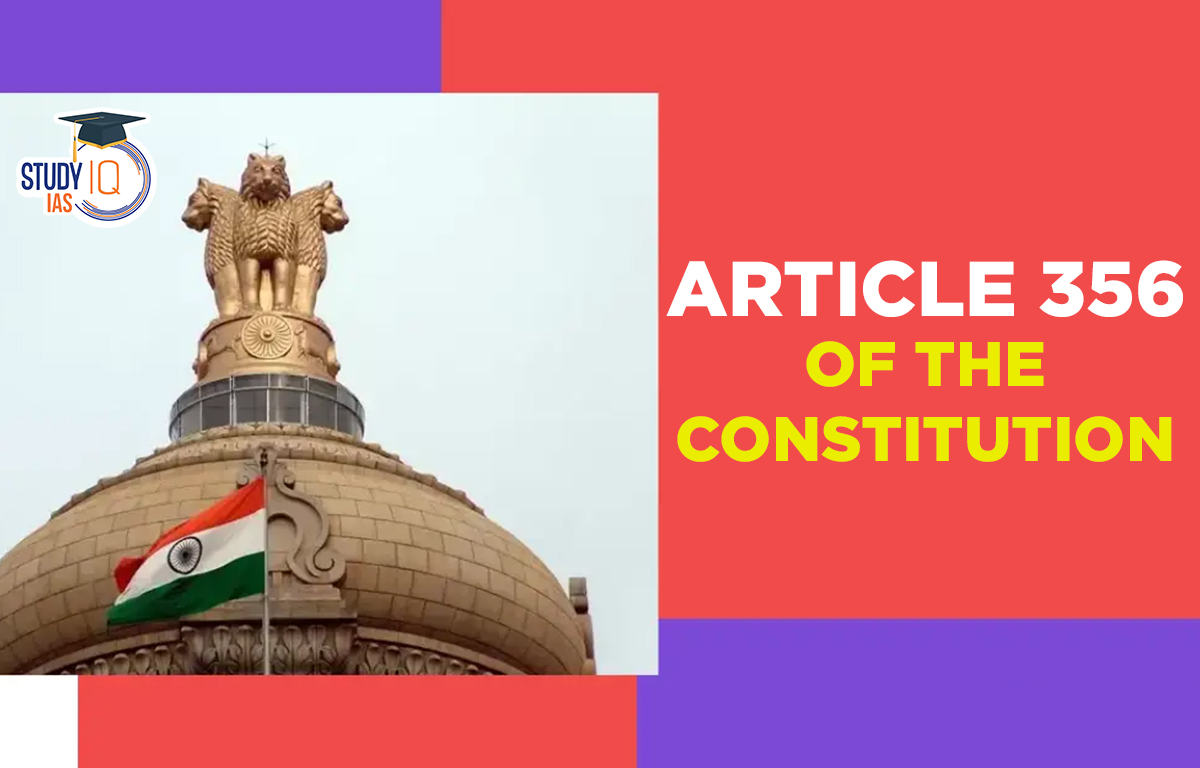Table of Contents
Context: History reveals that the provision of Article 356, i.e President’s Rule has been used a number of times to dismiss the elected State Governments.
About Article 356
- Article 356 of the Indian Constitution contains provisions for the imposition of “President’s Rule” in a state.
- Article 356 empowers the President to withdraw to the Union the executive and legislative powers of any state “if he is satisfied that a situation has arisen in which the government of the state cannot be carried on in accordance with the provisions of the Constitution”.
- Duration: It can be imposed for six months at a time for a maximum duration of three years.
- Every six months, Parliamentary approval to impose President’s Rule will be required again.
- Origin of Article 356: It is inspired by Section 93 of the Government of India Act, 1935.
- If a Governor of a province was satisfied that a situation had arisen in which the government of the province cannot be carried on in accordance with the provisions of the said Act, he could assume to himself all or any of the powers of the government and discharge those functions in his discretion.
- However, Governor could not encroach upon the powers of the high court.
- Section 93 allowed the British authorities to exercise ultimate power when they deemed it necessary.

Implication of Article 356
- The President can assume to himself all or any of the functions of the State Government or he may vest all or any of those functions with the Governor or any other executive authority.
- The President may dissolve the State Legislative Assembly or put it under suspension. He may authorise the Parliament to make laws on behalf of the State Legislature.
- The President can make any other incidental or consequential provision necessary to give effect to the object of the proclamation.
- President is not, however, authorised to assume the powers of the High Court or to suspend any constitutional provision pertaining to it.
- It has no effect on the Fundamental Rights of the citizens.
Significance of Article 356
- If there is a hung assembly as a result of the assembly election.
- If the party with the most votes decides against forming a government.
- No one is able or willing to form a government.
- If the State has disregarded the instruction given by the Union.
- Internal subversion is when a government consciously violates the law or the constitution.
- If there is a physical breakdown, that is, if the government consciously chooses not to carry out its duties and provide for state governance.
- Dr. B.R. Ambedkar hoped Article 356 to be a dead letter. However, the provision has been used as a deadly weapon by various governments.
Instances of Implementation of Article 356
- Until 1959, government had used the article six times, including to dislodge the first-ever elected communist government in the world, in Kerala in 1959.
- In the 1960s, it was used 11 times.
- After 1966, Article 356 was used seven times between 1967 and 1969 alone. Between 1970 and 1974, President’s Rule was imposed 19 times.
- Post Emergency, the government used it in 1977 to summarily dismiss nine Congress state governments.
- In 1980, the government-imposed President’s Rule in nine states.
Judiciary on Article 356
- In S.R. Bommai case (1994), the Supreme Court of India put forth strict guidelines for the imposition of Article 356.
- The proclamation (of President’s Rule) is subject to judicial review on grounds of mala fide intention.
- The court has the power to revive the suspended or dissolved state government if the grounds for the imposition are found to be invalid and unconstitutional.
- The state assembly cannot be dissolved before parliamentary approval for the imposition of Article 356 and the President can only suspend the assembly.
- Any action by the state government that leads to the security of secularism (which is a basic feature of the Constitution) cannot be grounds for the use of Article 356.
- Article 356 cannot be used to sort out any intraparty issues in the ruling party.
- If the Ministry of the state resigns or is dismissed or loses the majority, then the governor cannot advise the President to impose this article until enough steps are taken by the governor for the formation of an alternative government.
- Exceptional Power: Power under Article 356 is to be used only in case of exigencies.
Various Committees to Reform Article 356
- Sarkaria Commission Report (1983)
- It recommended that Article 356 should be used “very sparingly” and only as a last resort.
- The President’s proclamation of President’s Rule should include reasons as to why he thinks the state cannot run normally.
- Whenever possible, the centre should give the state government a warning before imposing Article 356.
- The Article should not be used for settling political scores.
- The commission recommended the amendment of the article in order for the President to be authorised to dissolve the state legislature only after getting parliamentary approval.
- Punchhi Commission (2007)
- Centre should try to bring only a specific troubled area under its jurisdiction and that too for a brief period, not more than three months.
- The commission recommended that suitable amendments should be made to incorporate the guidelines established by SC in the Bommai case.
- The commission recommended the provision of a ‘Localized Emergency’ which implies that the centre can tackle issues at town/district (local) level without dissolving the state legislative assembly while at the same time, performing the duty of the Union to protect States as per Article 355.



 Daily Quiz 17 April 2025
Daily Quiz 17 April 2025
 Nilgiri Biosphere Reserve, Map, Climate,...
Nilgiri Biosphere Reserve, Map, Climate,...
 Complete List of Indian State Animals
Complete List of Indian State Animals





















